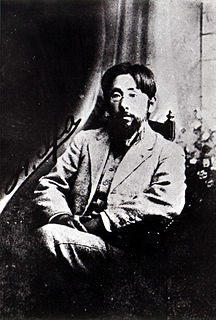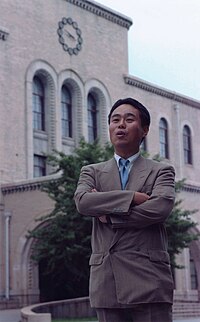 W
WIkuhiko Hata is a Japanese historian. He acquired his PhD at the University of Tokyo and has taught history at several universities. He is the author of a number of influential and well-received scholarly works, particularly on topics related to Japan's role in the Second Sino-Japanese War and World War II.
 W
WHigashionna Kanjun (東恩納寛惇) also Higaonna Kanjun (1882–1963) was a Japanese scholar who specialized in the history of Okinawa. Alongside Iha Fuyū and Majikina Ankō (真境名安興), he is considered one of the pioneers of modern Okinawan studies. After reading Japanese history at Tokyo Imperial University, where he wrote his dissertation on the approach of the Shimazu clan towards the Ryūkyū Kingdom, his subsequent career included posts at Hosei University and Takushoku University and travels in Southeast Asia and India. His extensive body of writings, collected as Higashionna Kanjun zenshū (東恩納寬惇全集) in ten volumes, centre around Ryukyuan history and culture, personal and place names, and classics such as the Omoro Sōshi. His private collection of documents and historical materials, numbering some 3,384 items, is preserved as the Higashionna Kanjun Collection at Okinawa Prefectural Library.
 W
WTomio Hora (洞 富雄, Hora Tomio, was a Japanese historian and Waseda University professor, well known for his pioneering work on the Nanjing Massacre.
 W
WHoshino Hisashi was a Japanese historian, active in the late 19th century debates over the role of Japanese history.
 W
WIha Fuyū was the father of Okinawaology and a Japanese scholar who studied various aspects of Japanese and Okinawan culture, customs, linguistics, and lore. His signature was Ifa Fuyu in English, because of the Okinawan pronunciation. Iha studied linguistics in the University of Tokyo and was devoted to the study of Okinawan linguistics, folklore, and history. His most famous book on the subject, Ko Ryūkyū, was published in 1911 and remains one of the best works on Okinawan studies. He devoted much time to the discovery of the origins of Okinawan people to establish their history. He had considerable influence not only on the study of Okinawan folklore but also of Japanese folklore.
 W
WNaoki Inose is a Japanese politician, journalist, historian, social critic and biographer of literary figures such as Yukio Mishima and Osamu Dazai. He served as Vice Governor of Tokyo from June 2007 until becoming Acting Governor on 1 November 2012 following the resignation of Shintaro Ishihara. He was elected Governor in a historical landslide victory in December 2012, but announced his resignation on December 19, 2013, following a political funds-related scandal; his resignation was approved and became effective December 24, 2013.
 W
WShuntarō Itō is a Japanese scholar of the history of science and the study of comparative civilization. Itō is an honorary professor of University of Tokyo and International Research Center for Japanese Studies, and a professor of Reitaku University, and the Chairman of Japan Seaology Promotion Organization. He is also a former president of the International Society for the Comparative Study of Civilizations.
 W
WNoboru Karashima was a Japanese historian, writer and Professor Emeritus in University of Tokyo, Japan. He also served as Professor Emeritus at the Taisho University, Japan. He was a prominent scholar of Asia in the studies of south Indian and South Asian histories. He has rewritten historical accounts on medieval south India and published a number of writings.
 W
WProf. Akio Katayama (片山章雄), a Japanese historian. He is a Professor of Oriental History and Inner Asian Studies at Tokai University.
 W
WKan Kimura is a Japanese scholar of political studies and area studies. He is now a professor at Graduate School of International Cooperation Studies, Kobe University, Japan.
 W
WKitabatake Chikafusa was a Japanese court noble and writer of the 14th century who supported the Southern Court in the Nanboku-cho period, serving as advisor to five Emperors. Some of his greatest and most famous work was performed during the reign of Emperor Go-Daigo, under whom he proposed a series of reforms, amounting to a revival or restoration of political and economic systems of several centuries earlier. In addition to authoring a history of Japan and a number of works defending the right of Go-Daigo's line to the throne, Kitabatake fought in defense of the Southern Court as a member of the Murakami branch of the Minamoto clan.
 W
WShinichi Kitaoka is a Japanese political scientist and the president of the Japan International Cooperation Agency (JICA) and a former president of the International University of Japan, a professor at Japan's GRIPS-Tokyo School of Security and International Studies and the former Japanese ambassador to the United Nations. His major is the history of Japanese politics and diplomacy, as a political scientist and a historian.
 W
WKume Kunitake was a historian in Meiji and Taishō period Japan. He had a son, Kume Keiichirō, who was a noted painter.
 W
WMajikina Ankō was a Japanese scholar who specialized in the history of Okinawa. Alongside Iha Fuyū and Higashionna Kanjun, he was considered one of the pioneers of modern Okinawan studies.
 W
WYasuhiro Matsuda is a Japanese professor of international politics at the University of Tokyo.
 W
WYoshio Mikami was a Japanese mathematician and historian of Japanese mathematics. He was born February 16, 1875 in Kotachi, Hiroshima prefecture. He attended the High School of Tohoku University, and in 1911 was admitted to the Imperial University of Tokyo. He studied history of Japanese and Chinese mathematics. In 1913, he published "The Development of Mathematics in China and Japan" in Leipzig. This book consisted of two parts with 47 chapters. Part one has 21 chapters that describe in depth several important Chinese mathematicians and mathematical classics including Liu Hui, Shen Kuo, Qin Jiushao, Sun Tzu, The Nine Chapters on the Mathematical Art, Mathematical Treatise in Nine Sections, Li Ye, Zhu Shijie and study on π. Part II deals with important wasan mathematicians and their works, including Kambei Mori, Yoshida Koyu, Kowa Seki, Imamura Chisho, Takahara Kisshu, Kurushima, Ajima Chokuyen, Aida Ammei, Shiraishi Chochu, Skabe Kohan, and Hagiwara Teisuke.
 W
WTakahito, Prince Mikasa was a Japanese royal, member of the Imperial House of Japan. He was the fourth and youngest son of Emperor Taishō (Yoshihito) and Empress Teimei (Sadako) and was their last surviving child. His eldest brother was Emperor Shōwa (Hirohito). After serving as a junior cavalry officer in the Japanese Imperial Army during World War II, the prince embarked upon a post-war career as a scholar and part-time lecturer in Middle Eastern studies and Semitic languages.
 W
WKoji Miyamoto is a Japanese professional wrestling historian and writer, best known for his work on Lou Thesz. He has authored sixteen books.
 W
WShigeaki Mori is a Japanese historian living in Hiroshima, Japan. He is known for his research into Allied prisoners of war who died during the air raids on Japan. His hug with U.S. President Barack Obama during the president's visit to Hiroshima gained world-wide attention.
 W
WNaitō Torajirō , commonly known as Naitō Konan , was a Japanese historian and Sinologist. He was the founder of the Kyoto School of historiography, and along with Shiratori Kurakichi, was one of the leading Japanese historians of East Asia in the early twentieth century. His most well-known book is called Nara.
 W
WShūmei Ōkawa was a Japanese nationalist, Pan-Asian writer and indicted war criminal. In the prewar period, he was known for his publications on Japanese history, philosophy of religion, Indian philosophy, and colonialism. He is frequently called a "right-wing" writer, although he described himself as anti-capitalist and rejected the label "right-wing".
 W
WIncorporates translated material from the corresponding Japanese Wikipedia article
 W
WŌtori Keisuke was a Japanese military leader and diplomat.
 W
WShiratori Kurakichi was a Japanese historian and Sinologist who was one of the pioneers of the field of "Oriental History". Shiratori graduated from Tokyo Imperial University and joined the staff of Gakushūin University in 1890. He later returned to Tokyo Imperial University where he became a professor.
 W
WViscount Suematsu Kenchō was a Japanese politician, intellectual and author, who lived in the Meiji and Taishō periods. Apart from his activity in the Japanese government, he also wrote several important works on Japan in English. He was portrayed in a negative manner in Ryōtarō Shiba's novel Saka no ue no kumo.
 W
WTaguchi Ukichi was a Japanese historian and Georgist economist of the Meiji period, and one of the foremost proponents of the bunmeishi view of history. He was elected to the House of Representatives of Japan in 1894. He is sometimes referred to as "the Japanese Adam Smith", as he wrote many journal articles advocating certain economic reforms and policies.
 W
WTakekoshi Yosaburō was a Japanese historian and politician, member of the Diet and Privy councillor. He was a graduate of Keiō Gijuku.
 W
WRyūsaku Tsunoda is known as the "father of Japanese studies" at Columbia University. He was directly responsible for developing the Japanese language and literature collection at Columbia's library. Prominent among the former-students who credit his influence as formative is Donald Keene, who had himself become a later Dean of Japanese studies in the United States.
 W
WVěnceslava Hrdličková also Věna was a leading Czech sinologist and Japanese historian.
 W
WBaron Yamakawa Kenjirō was a Japanese samurai of the late Edo period who went on to become a noted physicist, university president, and author of several histories of the Boshin War. Though his name is commonly written "Yamakawa," he himself wrote it as "Yamagawa" in English.
 W
WMasatada Yamasaki was a gynecologist and president of Kumamoto Medical College (1925–1932). He wrote The history of medical education in Higo (Kumamoto) and Yokoi Shōnan. After retirement, he travelled in Okinawa.